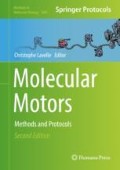Abstract
Transmission electron microscopy (TEM) and atomic force microscopy (AFM) are powerful tools to study the behavior of various actors in homologous recombination including molecular motors such as recombinases and helicases/translocases. Here we present specific approaches developed in terms of sample preparation and imaging methods to contribute to the understanding of homologous recombination process and its regulation focusing on the interplay between recombinases and other related proteins such as mediators or antirecombinase actors.
Homologous recombination (HR) is a high-fidelity DNA repair pathway since it uses a homologous DNA as template. Recombinases such as RecA in bacteria, RadA in archaea, and Rad51 in eukaryotes are key proteins in the HR pathway: HR is initiated with formation of an ssDNA overhang on which recombinases polymerize and form a dynamic active nucleoprotein filament able to search for homology and to exchange DNA strand in an ATP-dependent manner. We provide practical methods to analyze presynaptic filament formation on ssDNA, its composition and regulation in presence of mediator partners, antirecombinase activity of translocase, and chromatin remodeling events.
Access this chapter
Tax calculation will be finalised at checkout
Purchases are for personal use only
References
Haber J (2014) Genome Stability: DNA repair and recombination. Taylor & Francis Inc
Bell JC, Kowalczykowski SC (2016) Mechanics and single-molecule interrogation of DNA recombination. Annu Rev Biochem 85:193–226
Symington LS, Rothstein R, Lisby M (2014) Mechanisms and regulation of mitotic recombination in Saccharomyces cerevisiae. Genetics 198:795–835
Zhao W, Vaithiyalingam S, San Filippo J, Maranon DG, Jimenez-Sainz J, Fontenay GV, Kwon Y, Leung SG, Lu L, Jensen RB et al (2015) Promotion of BRCA2-dependent homologous recombination by DSS1 via RPA targeting and DNA mimicry. Mol Cell 59:176–187
Veaute X, Jeusset J, Soustelle C, Kowalczykowski SC, Le Cam E, Fabre F (2003) The Srs2 helicase prevents recombination by disrupting Rad51 nucleoprotein filaments. Nature 423:309–312
Le Cam E, Delain D, Larquet E, Culard F, Cognet JA (2000) DNA-protein complexes analysed by electron microscopy and cryp-microscopy. In: Travers A, Buckle M (eds) DNA-protein interactions. Oxford University Press, pp 337–350
Dupaigne P, Le Breton C, Fabre F, Giangloff S, Le Cam E, Veaute X (2008) The Srs2 helicase activity is stimulated by Rad51 filaments on dsDNA: implications for crossover incidence during mitotic recombination. Mol Cell 29:243–254
De Cian A, Praly E, Ding F, Singh V, Lavelle C, Le Cam E, Croquette V, Piétrement O, Bensimon D (2012) ATP-independent cooperative binding of yeast Isw1a to bare and nucleosomal DNA. PLoS One 7:e31845
Piétrement O, Pastré D, Fusil S, Jeusset J, David M-O, Landousy F, Hamon L, Zozime A, Le Cam E (2003) Reversible binding of DNA on NiCl2-treated mica by varying the ionic strength. Langmuir 19:2536–2539
Vesenka J, Guthold M, Tang CL, Keller D, Delaine E, Bustamante C, Delain E (1992) Substrate preparation for reliable imaging of DNA molecules with the scanning force microscope. Ultramicroscopy:42, 1243–44, 1249
Hansma HG, Sinsheimer RL, Li MQ, Hansma PK (1992) Atomic force microscopy of single- and double-stranded DNA. Nucleic Acids Res 20:3585–3590
Pastré D, Piétrement O, Fusil SS, Landousy F, Jeusset J, David M-O, Hamon L, Le Cam E, Zozime A, Pastré D et al (2003) Adsorption of DNA to Mica mediated by divalent Counterions: a theoretical and experimental study. Biophys J 85:2507–2518
Rouzina I, Bloomfield VA (1998) DNA bending by small, mobile multivalent cations. Biophys J 74:3152–3164
Hamon L, Pastré D, Dupaigne P, Le Breton C, Le Cam E, Piétrement O (2007) High-resolution AFM imaging of single-stranded DNA-binding (SSB) protein-DNA complexes. Nucl Acids Res 35:e58
Lyubchenko YL, Jacobs BL, Lindsay SM (1992) Atomic force microscopy of reovirus dsRNA: a routine technique for length measurements. Nucleic Acids Res 20:3983–3986
Lyubchenko YL, Shlyakhtenko LS (2009) AFM for analysis of structure and dynamics of DNA and protein-DNA complexes. Methods 47:206–213
Pastré D, Hamon L, Landousy F, Sorel I, David M-O, Zozime A, Le Cam E, Piétrement O (2006) Anionic polyelectrolyte adsorption on mica mediated by multivalent cations: a solution to DNA imaging by atomic force microscopy under high ionic strengths. Langmuir 22:6651–6660
Mortier-Barrière I, Velten M, Dupaigne P, Mirouze N, Piétrement O, McGovern S, Fichant G, Martin B, Noirot P, Le Cam E et al (2007) A key presynaptic role in transformation for a widespread bacterial protein: DprA conveys incoming ssDNA to RecA. Cell 130:824–836
Esta A, Ma E, Dupaigne P, Maloisel L, Guerois R, Le Cam E, Veaute X, Coïc E (2013) Rad52 Sumoylation prevents the toxicity of unproductive Rad51 filaments independently of the anti-recombinase Srs2. PLoS Genet 9:e1003833
Dupaigne P, Lavelle C, Justome A, Lafosse S, Mirambeau G, Lipinski M, Piétrement O, Le Cam E (2008) Rad51 polymerization reveals a new chromatin remodeling mechanism. PLoS One 3:e3643
Kantake N, Sugiyama T, Kolodner RD, Kowalczykowski SC (2003) The recombination-deficient mutant RPA (rfa1-t11) is displaced slowly from single-stranded DNA by Rad51 protein. J Biol Chem 278:23410–23417
Zaitseva EM, Zaitsev EN, Kowalczykowski SC (1999) The DNA binding properties of Saccharomyces cerevisiae Rad51 protein. J Biol Chem 274:2907–2915
Liu J, Renault L, Veaute X, Fabre F, Stahlberg H, Heyer W-D (2011) Rad51 paralogues Rad55-Rad57 balance the antirecombinase Srs2 in Rad51 filament formation. Nature 479:245–248
Fuller FB (1971) The writhing number of a space curve. Proc Natl Acad Sci U S A 68:815–819
Sivolob A, Lavelle C, Prunell A (2003) Sequence-dependent nucleosome structural and dynamic polymorphism. Potential involvement of histone H2B N-terminal tail proximal domain. J Mol Biol 326:49–63
Author information
Authors and Affiliations
Corresponding author
Editor information
Editors and Affiliations
Rights and permissions
Copyright information
© 2018 Springer Science+Business Media, LLC, part of Springer Nature
About this protocol
Cite this protocol
Dupaigne, P., Tavares, E.M., Piétrement, O., Le Cam, E. (2018). Recombinases and Related Proteins in the Context of Homologous Recombination Analyzed by Molecular Microscopy. In: Lavelle, C. (eds) Molecular Motors. Methods in Molecular Biology, vol 1805. Humana Press, New York, NY. https://doi.org/10.1007/978-1-4939-8556-2_13
Download citation
DOI: https://doi.org/10.1007/978-1-4939-8556-2_13
Published:
Publisher Name: Humana Press, New York, NY
Print ISBN: 978-1-4939-8554-8
Online ISBN: 978-1-4939-8556-2
eBook Packages: Springer Protocols

